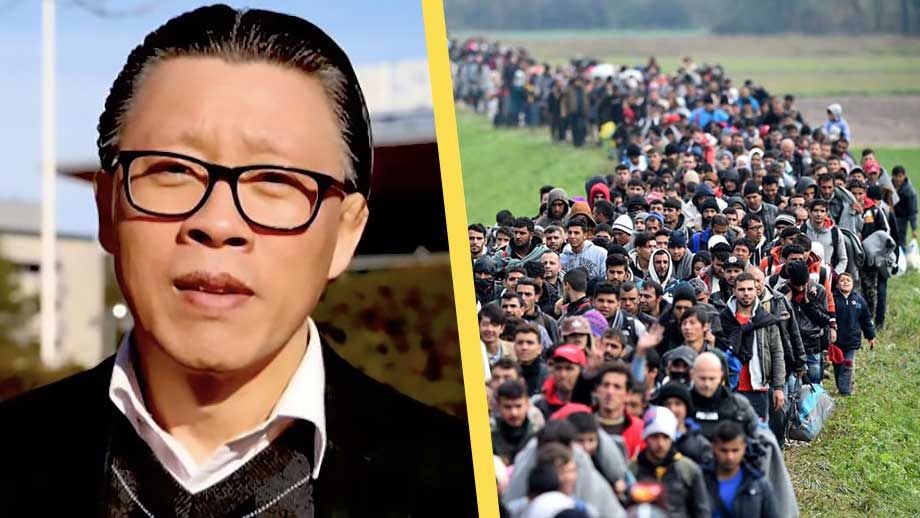Sweden is lost
Radical left-wing racial scientist confirms ongoing "people exchange"
Published 09:30 AM
The controversial left-wing radical racial researcher Tobias Hübinette refutes in a recent post on his blog that the claims that there is an ongoing mass immigration-driven "people exchange" in Sweden would be a far-right conspiracy theory, as claimed by leading political parties. With figures from Statistics Sweden, he shows that it is instead a tangible reality.
In the debate critical of mass immigration, what Sweden has been exposed to for a number of decades has been called a "people exchange". Since the proportion of the population that has an immigrant background has increased dramatically in a short time and the underlying reason for this is political decisions, it is believed that the choice of words is justified.
On the political left, it has been argued that only extreme right-wing conspiracy theorists use concepts such as "mass immigration" and "people exchange". At a press conference in 2020 in connection with a parliamentary committee handing over its migration policy report to the Minister of Justice and Migration, Morgan Johansson, he took the opportunity to emphasize this.
However, statistics from the Central Statistics Office (SC show that there are no conspiracy theories at all, unless you mean that the authority engages in such and publishes false figures. Nor is it true that it is only right-wing extremists who highlight this demographic development.
The left-wing radical race researcher confirms
Racial researcher Tobias Hübinette is on the left-wing radical side of the political spectrum in terms of identity politics and has repeatedly drawn attention to Sweden's rapid transformation from an ethnically homogeneous country populated by native ethnic Swedes to today approaching the breaking point where they are becoming a minority at the national level . Locally, that limit has already been exceeded by a large margin in many places.
And on Wednesday, Hübinette devotes another post on her blog to shining the spotlight on this phenomenon. This is due to Statistics Sweden's publication on the same day of my statistics on Sweden's demographic transformation, figures that extend until the turn of the year.
The state statistics agency is not known for publishing its figures in a way that is easily comprehensible and educational for the common man. University academic Hübinette helps to sort things out.
Close to 35 percent have a foreign background
Close to 35 percent (34.62) of the country's inhabitants had some form of foreign background when the New Year's rockets were last postponed. Those numbers do not include the migrants who stay illegally in Sweden and are estimated to amount to a couple of hundred thousand.
Foreign background is defined here as having either immigrated to Sweden yourself or having at least one parent who did so. Adoptees from abroad are also included.
Hübinette also emphasizes that a majority within this population share has a non-Western immigrant background, with all that this entails in terms of integration challenges. At young ages, that dominance is even more evident.
In multi-ethnic second place after the USA
In just a few decades, Sweden has almost caught up with the world leader USA in terms of having a multi-ethnic population and shares second place with countries such as Canada, Australia, New Zealand, France, Great Britain and the Netherlands.
The three metropolitan regions, Stockholm, Malmö and Gothenburg, are the ones where population exchange has gone the furthest - In Greater Stockholm at the turn of the year, 46.13 percent had a foreign background, in Stormalmö: 43.77 percent and in Greater Gothenburg 38.43 percent.
Hübinette also illustrates with numbers over time how fast and dramatic this politically determined demographic upheaval has been. In 1950 only 4.3 percent had a foreign background, 1960 6.2 percent, 1970 10.6 percent, 1980 13.1 percent, 1990 16.2 percent, 2002: 21.38 percent, 2007: 23.99 percent, 2012 27 .24 percent, in 2017 31.55 percent and in 2022 34.63 percent.
There has also been an equally dramatic shift in where the immigrants come from, from previously originating in the Nordics, Europe and the rest of the Western world to coming from Africa, the Middle East, Asia, Latin America and the Caribbean. In 1960, as few as 0.1 percent of immigrants had non-Western origins. By 2022, that figure had risen to 19 percent, and most of that development has occurred in the past two decades.
https://samnytt.se/vansterradi....kal-rasforskare-bekr
Install our *FREE* WEB APP! (PWA)
Explore
© 2026 YubNub Social
About •
Directory • Contact Us •
Developers • Privacy Policy •
Terms of Use
• shareasale
• FB Webview Detected
• Android
• Apple iOS
• Get Our App










